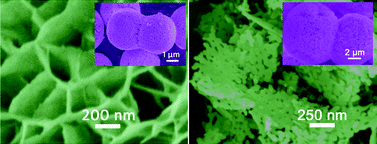A facile strategy to correlate the thermal decomposition of inorganic–organic hybrid with the Kirkendall effect appearing during the oxidation process of sulfides into oxides has been developed to synthesize hierarchical-porous-structured metal oxide microspheres by using ceria as the model system. The as-prepared hierarchical-porous-structured ceria with micropores, mesopores and macropores (HC3M) possesses a very high surface area (over 290 m2 g−1) and high thermal stability. We have also demonstrated that the pore size of mesopores in HC3M can be modulated by controlling the oxidation and decomposition temperature of the hybrid precursors. Our preliminary results of the preferential oxidation of carbon monoxide in the H2-rich stream (PROX) show that both the conversion and selectivity of the Cu/HC3M catalyst are obviously higher than those of Cu/CeO2 particles. The improved catalytic activity may be attributed to the high dispersion and the smaller size of Cu on HC3M, the high specific surface area and unique hierarchical porous structure of HC3M support. Thus, the hierarchical-porous-structured ceria is expected to find promising applications in catalysis, sensors and fuel cells. In addition, the method to convert inorganic–organic hybrid sulfides into oxides can be successfully extended to the synthesis of hierarchical-porous-structured Y-doped and La-doped ceria with the modulated composition. Through the designed preparation of inorganic–organic hybrid sulfides, selenides or tellurides followed by the oxidation and thermal decomposition at suitable temperature, we believe that this conversion of hybrid materials into oxides might be extended to fabricate other hierarchical-porous-structured oxides with improved physical and/or chemical properties.

You have access to this article
 Please wait while we load your content...
Something went wrong. Try again?
Please wait while we load your content...
Something went wrong. Try again?


 Please wait while we load your content...
Please wait while we load your content...